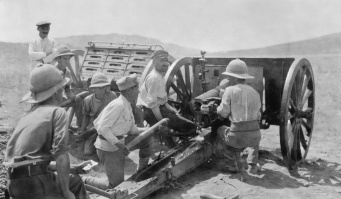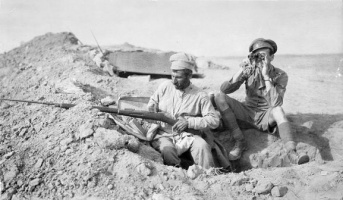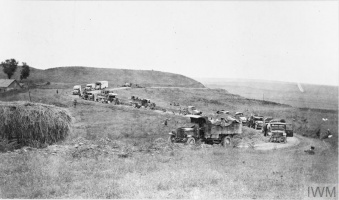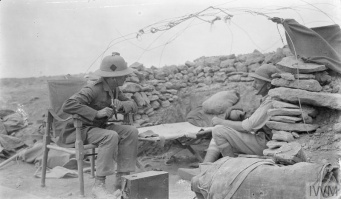The Situation at the Front in 1914-1915↑
The Ottoman naval bombardment of Russian ports in the Black Sea on 29-30 October 1914, known as the Black Sea Raid, led to Russia declaring war on the Ottoman Empire. The Russian Caucasus Army crossed the frontier on 2 November in the Bergmann Offensive, capturing Köprüköy on 7 November. [1] By 20 October, the army consisted of 100 battalions, 117 sotnias [2] and 256 field guns, with a total strength ranging from 51,700 to 71,700 men. [3] Russian forces were supported by four combat and one reserve Armenian volunteer druzhinas, or squads, each numbering from a few hundred to 1,000 Russian Armenians, most of whom were not citizens of the Russian Empire nor otherwise obliged to serve. Two more squads were raised as the war progressed.[4] The Ottoman Third Army, which had about 150,000 men assigned to it,[5] counterattacked on 11 November, and the Russian flanks became vulnerable, forcing a Russian retreat from Köprüköy. The success boosted Ottoman Minister of War Ismail Enver’s (1881-1922) faith in the ability of his troops to achieve swift victory.
On 22 December, elements of the Third Army, numbering 118,660 troops,[6] began advancing on Russian positions across the Allahüekber Mountains. By 25 December, two army corps had advanced well north of the Russians and began deploying southward to intercept the Russian line of retreat and close the encirclement. However, they were lured into Russian traps. During 1 and 2 January 1915, the Russians launched a counterattack at Sarıkamış that cost the lives of tens of thousands of Turkish soldiers. Casualties during the entire Sarıkamış operation varied from 78,000[7] to as many as 90,000,[8] including 30,000[9] who froze to death. Russian losses were placed at around 16,000 killed and wounded. Thoroughly outmanoeuvred by his Russian rivals, Enver blamed the defeat on Armenians, using some Armenian desertions as a pretext, even though Armenian soldiers and officers in the Ottoman army generally fought loyally and bravely.[10] The Turkish debacle at Sarıkamış triggered the Armenian Genocide, which was begun by the Ottoman state on 24 April.
Throughout the rest of the year, the situation on the front remained relatively calm. In the spring of 1915, the V Caucasian Army Corps consisting of the Third Caucasian Rifle Division and First and Second Kuban Plastun Brigades, as well as the Twentieth Infantry Division - all totaling 43 battalions or from 17,200 to 25,800 men, were deployed from the Caucasus to the Western Front. At about the same time, the Caucasus Front was reinforced by about 40 new battalions or from 16,000 to 24,000 men.[11] After the Allies withdrew from Gallipoli, the Ottoman general staff received the opportunity to reinforce the Third Army with up to sixteen infantry divisions, which were involved in fighting[12] in preparation for a spring offensive. In December, commander of the Russian Caucasus Army Nikolaĭ Yudenich (1862-1933) formulated a plan for a pre-emptive strike on Erzurum, to begin the following month.
The Situation at the Front in 1916↑
In the euphoria of celebrating the defeat of the Allied forces in Gallipoli, the Ottoman general staff believed that Erzurum would stand impervious to Russian assault. The staff allocated seven divisions freed from Gallipoli to the Caucasus but delayed their departure until February. But already between 10 and 19 of January, Russian forces launched a daring attack at Erzurum, outflanking Köprüköy, 53 kilometres east of Erzurum, and reducing the amount of Ottoman manpower there. The commander of the Third Army, Mahmud Kâmil (1880-1922), set up a line of defence that depended on characteristics of the terrain rather than on trench lines manned by infantrymen. As the line deteriorated, his soldiers retreated to Erzurum where, with more troops and fortress artillery, they hoped to put up a stiffer fight. The fighting resulted in 20,000 Turkish casualties, 10,000 Russian casualties and 2,000 Russians with severe frostbite.[13]
The general offensive on the forts of Erzurum began on 10 February when the Fourth Caucasian Rifle Division ascended the slopes of the Kargapazar ridge. On 14 February, the division began its descent. It linked up with the II Turkistan Corps at the Karagöbek fort and began an advance on the Tafet fort. Outflanked, the Ottomans evacuated Tafet and dropped back. On 15 February, they blew up several forts and evacuated the Çoban-dede fort. Russian troops entered Erzurum the following day. The Ottoman losses were placed at 10,000 killed and wounded, with 5,000 taken prisoner. Russian losses included 1,000 killed, 4,000 wounded, and 4,000 lost to frostbite.[14] Enver ordered the V and XVI Corps and the Fifth Infantry Division – formed into the Second Army – to march on Erzurum. However, by the time the army arrived, the Russians had consolidated their gains and were able to withstand the counteroffensive.
In April, Yudenich divided his forces in two. One column moved north and captured Trabzon. After the Ottoman attempt to retake the town failed, the Russians counterattacked on 2 July striking at Erzincan, 140 kilometres south of Trabzon. The second column headed south towards Bitlis and Muş in eastern Asia Minor. Between 2 March and 24 August, Russian forces overwhelmed the Ottoman Second Army and pushed it back deep into Anatolia. Mustafa Kemal (1881-1938), the commander of the XVI Corps, counterattacked and retook Bitlis and Muş, halting the Russian drive into Mesopotamia, where a link-up with the British could encircle Ottoman forces. However, further advances to recapture Van were stopped at Gevaş, south of Lake Van, and by late September, the Ottoman counterattacks had ended. By the end of 1916, the Russians were in control of a large tract of eastern Asia Minor, stretching for nearly 355 kilometres from Trabzon to Bitlis.
The End of Hostilities in 1917↑
The imminent Russian advance into central Anatolia and northern Mesopotamia was halted after the February Revolution, and the disintegrated Russian Caucasus Army was replaced by Armenian irregular units and the Allied expeditionary mission “Dunsterforce”. The departure of Russian troops gave the Ottomans the opportunity to recover the pre-war frontiers. On 18 December at Erzincan, they signed an armistice with the Transcaucasian Commissariat, the region’s first independent government, which formally ended the fighting in the Caucasus. Despite this, the Turks continued offensive operations, taking advantage of the fact that the Caucasus Front had effectively ceased to exist as a cohesive theatre of operations. The signing of a peace treaty at Brest-Litovsk on 3 March 1918 between the new Bolshevik government of Russia and the Ottoman Empire put an end to all hostilities.
Tigran Martirosyan, University of Amsterdam
Section Editors: Pınar Üre; Erol Ülker
Notes
- ↑ Russkiĭ invalid [The Russian Handicapped], 26 October 1914, no. 241, p. 1.
- ↑ A Cossack unit of 100-150 persons.
- ↑ Maslovskiĭ, Evgenīĭ: Velikaia voĭna na Kavkazskom fronte, 1914-1917 [The Great War in the Caucasus Front, 1914-1917], Moscow 2015, p. 421.
- ↑ Nikolaĭ Podpryatov, ‘Armianskie strelkovye bataliony v gody Pervoĭ mirovoĭ voĭny’ [Armenian Rifle Battalions during the First World War], Manuscript 2 (40), 2014, p. 159.
- ↑ Erickson, Edward J.: Ordered to Die. A History of the Ottoman Army in the First World War, Westport et al. 2001, p. 57.
- ↑ Ibid.
- ↑ Liman von Sanders, Five Years in Turkey 1927, p. 40.
- ↑ Larcher, Maurice: La guerre turque dans la guerre mondiale, Paris 1926, p. 389.
- ↑ Korsun, Nikolaĭ: Pervaia mirovaia voĭna na Kavkazskom fronte. Operativno-strategicheskiĭ ocherk [The First World War in the Caucasus Front: An Operational-Strategic Sketch], Moscow 1946, p. 37.
- ↑ Report from the Head of the German Information Service for the Orient, Baron Max von Oppenheim, to the Imperial Chancellor, 1915-08-29-DE-001 (Source: PA-AA; R 14087; A 27584; pr. 21.09.1915 p.m., Damascus, 29 August 1915), in: Gust, Wolfgang (ed.): The Armenian Genocide. Evidence from the German Foreign Office Archives, 1915-1916, New York et al. 2014, p. 333.
- ↑ Maslovskiĭ, Mirovaia voĭna 2015, p. 34.
- ↑ Erickson, Edward J.: Gallipoli and the Middle East, 1914-1918, London 2012, p. 92.
- ↑ Allen, William Edward David / Muratoff, Paul: Caucasian Battlefields. A History of Wars on the Turco-Caucasian Border, 1828-1921, Cambridge 1953, p. 342.
- ↑ Ibid., p. 363.
Selected Bibliography
- Akbay, Cemal: Birinci Dünya Harbi'nde Türk harbi. Kafkas cephesi. 3ncü ordu harekâtı (Turkey’s war in the First World War. Caucasus Front. Operations of the Third Army), Ankara 1993: T. C. Genelkurmay Başkanlığı.
- Allen, William Edward David / Muratoff, Paul: Caucasian battlefields. A history of the wars on the Turco-Caucasian border, 1828-1921, Cambridge 1953: Cambridge University Press.
- Arutiunian, Ashot Osipovich: Kavkazskiĭ front, 1914-1917 gg. (The Caucasus Front, 1914-1917), Yerevan 1971: Aiastan.
- Guse, Felix: Die Kaukasusfront im Weltkrieg, bis zum Frieden von Brest, Leipzig 1940: Koehler & Amelang.
- Maslovskiǐ, Evgenīĭ Vasil’evich: Mirovai︠a︡ voǐna na Kavkazskom fronte (The Great War on the Caucasus Front), Paris 1933: Vozrozhdenie.













